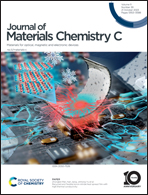Dynamics of the phase transition in Bi0.5Na0.5TiO3 based on in situ Raman spectroscopy
Abstract
This work aims to provide a thorough analysis of the phase transition dynamics in lead-free Bi0.5Na0.5TiO3 by in situ Raman spectroscopy, which is conducted under varying temperature and electric field. All the transition points are proved by the Raman response of phonon vibration, including the depolarization temperature at ∼200 °C, potential transition at ∼280 °C, Curie temperature at ∼320 °C and tetragonal-cubic transition above ∼500 °C. The vibration of A-site ions primarily contributes to the depolarization behavior, which is also responsible for the strong polarity in Bi0.5Na0.5TiO3. The transitions at ∼280 °C and ∼320 °C are confirmed by the phonon vibrations of the Ti–O bonds and the TiO6 octahedra. Meanwhile, the distortion of the Ti–O bonds and TiO6 octahedra under an electric field results in weak polarity. The thermal hysteresis behavior is related to the dynamics of phonon thermal evolution, because of the delayed response of the vibration mode to thermal activation of Ti–O bonds and TiO6 octahedra. The results lay a foundation for understanding the mechanism of the phase transition and polarization in Bi0.5Na0.5TiO3, guiding the design of functional devices for electromechanical applications.



 Please wait while we load your content...
Please wait while we load your content...